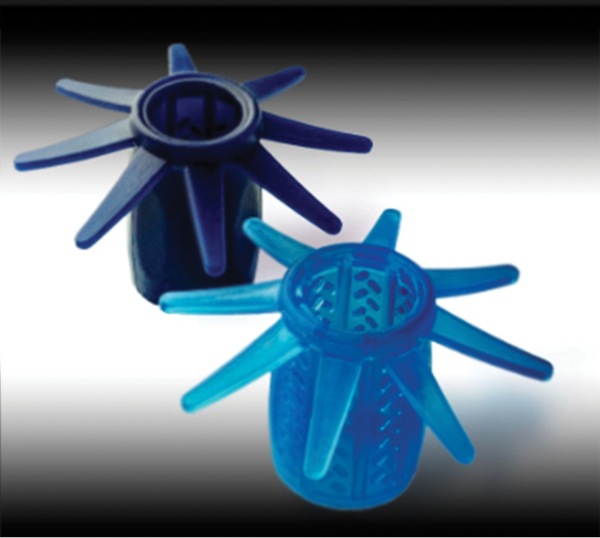Orlando, Fla.—Given the theoretical advantage of smoothing mucosal folds, devices that flatten the colon during endoscopy should reveal more polyps. But do they?
Two new studies—one retrospective, one randomized—show the gains from colonoscopy assist devices now available commercially are real. But, how much they will boost a skilled endoscopist's ability to detect adenomas remains unclear.
Presented at the 2017 World Congress of Gastroenterology/American College of Gastroenterology, the randomized study compared unassisted conventional colonoscopy (CC) and colonoscopy assisted with the Olympus transparent cap (TC) or the Olympus Endocuff Vision (EV) (abstract 39). The retrospective analysis (abstract P1029) compared CC, EV and the Medivators AmplifEYE (AE).

Endocuff Vision from Olympus.
The assist devices obey the same principle: Flattened mucosa should reveal polyps obscured by folds. All devices fit on the end of existing colonoscopes, but the technologies differ. The Olympus TC is designed to maintain an appropriate depth of field while preventing the scope from coming into direct contact with the mucosal membrane. The more sophisticated EV has finger-like projections that permit more controlled flattening of the mucosal folds. The AE device, which is the newest option, also has flexible extensions to stretch and flatten mucosal folds.
"The differences between the devices were not very striking, but our data show that using a device is much better than not using a device," reported Talal Alkayali, MBBS, of the H.H. Chao Comprehensive Digestive Disease Center at the University of California, Irvine, who helped conduct the retrospective study. He called this analysis, which included data from 1,186 screening and surveillance colonoscopies performed by 32 colonoscopists, the first side-by-side comparison of EV and AE.
The study was based on colonoscopies conducted between September 2016 and May 2017. Of these, 520 were CC, 312 were performed with EV and 354 were performed with AE. There were some differences between groups. For example, the cecal intubation rate (CIR) was lower in the CC group (97.3%) than in the EV or AE groups (both >99%; P=0.012).

AmplifEYE from Medivators.
The adenoma detection rate (ADR) was 30% for CC, 54% for EV and 50% for AE, indicating significant superiority of the assist devices (P<0.001 for both vs. CC). The serrated polyp detection rate (SDR) was 7% for CC, 13% for EV (P=0.004 vs. CC) and 14% for AE (P=0.002 vs. CC). When stratified by sex, the detection rates were numerically greater and usually significantly greater for both assist devices relative to CC.
The other study, billed as the first randomized controlled trial to compare EV, TC and CC, enrolled 126 patients. Sooraj Tejaswi, MD, director of the gastroenterology fellowship program at the University of California, Davis Medical Center, in Sacramento, led the trial (abstract 39).
When performed by three experienced colonoscopists with baseline ADRs ranging from 43% to 55%, few differences between colonoscopy techniques reached statistical significance. The one exception was mean ADR, which was 1.7 in the EV group versus 1.1 for CC and 0.76 for TC (P=0.03 for EV vs. TC), but the higher mean ADR per positive colonoscopy was not significant for EV versus the other methods. EV was associated with a numerically higher ADR (54.8%) than CC (52.3%) or TC, but the ADR for CC was higher than for the cap (40.5%).
"There was no statistical difference with respect to ADR between EV and CC, which may be accounted for by the high prestudy baseline ADR with our experienced endoscopists," said Joseph Marsano, MD, a GI fellow at UC Davis, who presented the data. The results do not rule out an advantage of EV for providers with lower ADRs, but more studies would be needed to evaluate that hypothesis, he said.
In the randomized study, patient demographics and procedure metrics, such as cecal intubation time, were similar in the three study arms. The ADR was 52% for CC, 40% for TC and 54% for EV. Other measured outcomes followed this same general pattern. For example, the ADR in the proximal colon was 45% for CC, 35% for TC and 50% for EV; the mean numbers of adenomas detected per positive colonoscopy were 2.08, 1.63 and 2.59 in the three arms. None of these differences was statistically significant. When the mean numbers of adenomas per colonoscopy were compared, the difference for EV (1.7) was significantly superior to TC (0.76; P=0.03) but not CC (1.1).
"An interesting finding of the randomized study was the numerically higher sessile serrated adenoma detection rate of 23.8% with EV compared to 16.7% for CC and 14.3% for TC," Dr. Tejaswi said. Although the study was not adequately powered to confirm this difference, Dr. Tejaswi said future research should explore whether assist devices have an advantage in increasing the detection rate of this type of adenoma.
At Dr. Alkayali's institution, the assist devices have been widely incorporated into routine practice. In the absence of clear differences between the attachments, experience or personal experience might be more important criteria for selecting one over another. "Further studies will give us verification of the results" and may distinguish relative advantages between available devices, he added.
Why the results of the two studies diverge is unclear. Although randomization provides greater objectivity for making a comparison, there are many variables, such as the skill of the endoscopist, that may be important in considering the utility of these devices in typical patient screening and for future comparative studies.
David Johnson, MD, chief of the Division of Gastroenterology at Eastern Virginia Medical School, in Norfolk, said although the attachments "may be helpful, particularly for less skilled endoscopists, the additional costs and willingness to invest into additional nonreimbursed equipment will be the challenge."
More data are needed to demonstrate the specific advantage of assist devices for both the detection of adenomas and serrated polyps and their ability to lead to definitive resection, Dr. Johnson said. These kinds of potential technical improvements are welcome, but "clearly, at present, the operator-dependent skills remain the backbone in ADR detection."